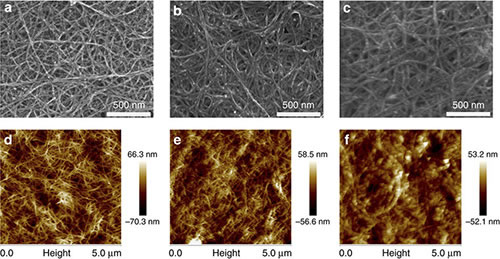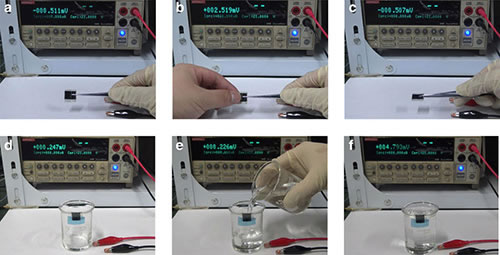The thermoelectric module can directly convert heat energy generated from natural heat sources (such as solar energy or geothermal energy) and industrial and domestic waste heat into valuable electric energy, realize the recycling of energy, and can also be used for solid-state refrigeration, in which the energy crisis and environmental pollution are increasingly serious. Today is of great significance. Facing the shortcomings of traditional inorganic thermoelectric materials, researchers have paid great attention to new flexible thermoelectric materials that are environmentally friendly and inexpensive. As thermoelectric modules, thermocouples consisting of p-type and n-type thermoelectric materials are the basic working units. With the development of flexible thermoelectric materials such as conductive polymers, metal coordination polymers, macro carbon nanotubes and carbon nanotubes/organic composites, the thermoelectric power factor of a flexible p-type thermoelectric material has reached 2000 μW m-1 at room temperature. K-2, performance can be comparable to inorganic thermoelectric materials, but high performance, high stability and flexible n-type thermoelectric materials are still lacking, which hinders the development of flexible thermoelectric modules.
The Institute of Physics, Chinese Academy of Sciences/Beijing National Laboratory for Condensed Matter Physics (CMM) Advanced Materials and Structure Analysis Laboratory The “Nanomaterials and Mesoscopic Physics†research group has been working on the preparation, properties, and applications of carbon nanotubes for many years. On the basis of previous work, the research fellow of the research group, academician of the Chinese Academy of Sciences Academician Zhou Wenbin, who is instructed by Si Sishen, and the group researchers Fan Qingxia, Zhang Qiang, Wang Yanchun, and Zhou Wei, etc., are based on direct-growing single-wall carbon nanotubes with a continuous network structure. The thin film has developed a flexible n-type thin film with excellent thermoelectric properties, and a compact flexible thermoelectric module with a unique structural advantage has been designed (Chinese invention patent application number .0) to fully integrate thermoelectricity of p- and n-type carbon nanotube films. Performance is optimized. The p-type carbon nanotube film directly adopts the continuous network carbon nanotube film prepared by the research group, which is an ideal green and flexible thermoelectric material, and has an excellent p-type thermoelectric power factor (maximum value of 2482 at room temperature. μW m-1 K-2) is one of the highest values ​​reported in the literature, and avoids the cumbersome process used to prepare p-type carbon nanotube nanocomposite films in the literature. The relevant research results were published in Small, 2016, 12, 3407.
Further, they applied a solution of polyethylene imine (PEI) in ethanol to allow the PEI molecules to coat the surface of the bundle of carbon nanotubes evenly in the presence of ethanol that can well infiltrate the carbon nanotube network. Efficient electron transfer allows the original p-type carbon nanotube film to be quickly converted to n-type without damaging it. At the same time, the uniform coating of PEI effectively forms a protective layer to prevent degradation of the n-type performance, so the prepared n-type carbon nanometer The optimal power factor of the tube film is 1500 μW m-1 K-2, which is the highest value reported in the literature. In addition, the unencapsulated film exhibits long-term stability in the air within three months of the test period. Has great practical potential. On this basis, a continuous thermoelectric module with a compact structure and a compact size was designed and successfully fabricated using a continuously grown large-area carbon nanotube film and a local doping process. Unlike the traditional π configuration, this compact thermoelectric module fully integrates the thermoelectric properties of p- and n-type carbon nanotube films to be optimized without depositing gold or silver top electrodes on individual thermoelectric legs. There is no need to use metal connecting wires between the p-type and n-type thermoelectric legs, the influence of contact resistance can be avoided and the preparation steps are simple and easy to mass produce. The resulting thermoelectric module has outstanding performance and is significantly better than previously reported results for a flexible thermoelectric device under similar test conditions. The carbon nanotube continuous network based thermoelectric film and compact thermoelectric module in this study showed attractive application prospects in portable and flexible thermoelectric conversion and novel sensing fields, and provided inspiration for industrialized preparation of flexible thermoelectric modules. The commercialization of flexible thermoelectric modules opens the door.
The relevant research results were published in Nature-Communications (Nat. Commun., 2017, 8, 14886). Zhou Wenbin, a Ph.D. student in the Institute of Physics, was the author of this article. She Sishen and Zhou Wei were co-authors. This work was supported by projects of the Ministry of Science and Technology (2012CB932302), the National Natural Science Foundation of China (11634014, 51172271, 51372269 and 51472264) and the Chinese Academy of Sciences' Nano Initiative (XDA09040202).

Figure 1 Thermoelectric properties and stability. (a) Electrical conductivity and Seebeck coefficient at room temperature, (b) Thermoelectric power factor of original and doped carbon nanotube films, (c) 1 wt.% PEI-doped film not encapsulated in air for a long time Stability, (d) Comparison of the thermoelectric power factor of the latest research on flexible n-type thermoelectric materials and the results of this study.

Figure 2 Morphological characterization. (a) SEM photograph and (b) AFM photograph of the original carbon nanotube film, (c) SEM photograph and (d) AFM photograph of 0.5 wt.% PEI-doped carbon nanotube film, 1 wt.% PEI doping (e) SEM photographs and (f) AFM photographs of the carbon nanotube films.

Figure 3 Schematic diagram of the preparation of the n-type thin film and compact flexible thermoelectric module (left) and the physical photo and device performance curves (right). In the right figure (a), a carbon nanotube multi-layer thin film is collected from a continuously grown large-area carbon nanotube film. (b) Carbon nanotube strips containing three pairs of consecutive pn couples. (c) A continuous type thermoelectric module was prepared. (d) Flexible display of modules. (e) Voltages generated at different steady-state temperature differences. (f) Voltage-current curve and power-current curve of the module at a hot junction temperature of 330 K and a temperature difference of 27.5 K.

Figure 4: A preliminary demonstration of thermoelectric conversion using a continuous flexible thermoelectric module using a heat source found in everyday life.
Steel Fence,Wrought Iron Fences,Iron Fence,Metal Fence
MINGYI METAL CRAFTS CO.,LIMITED , https://www.mingyi-ironware.com
![<?echo $_SERVER['SERVER_NAME'];?>](/template/twentyseventeen/skin/images/header.jpg)